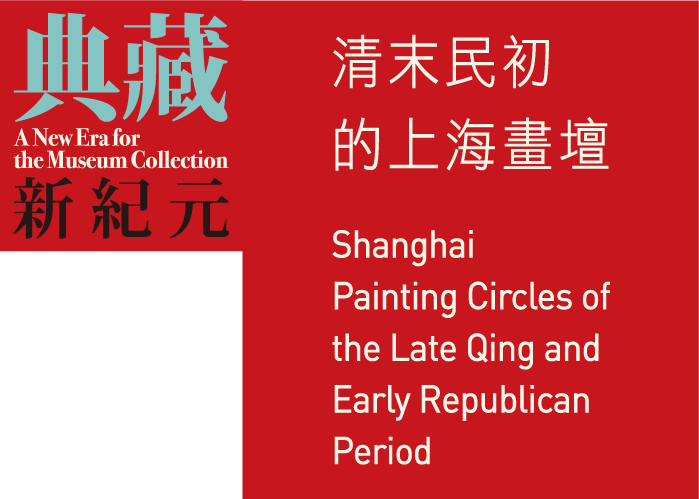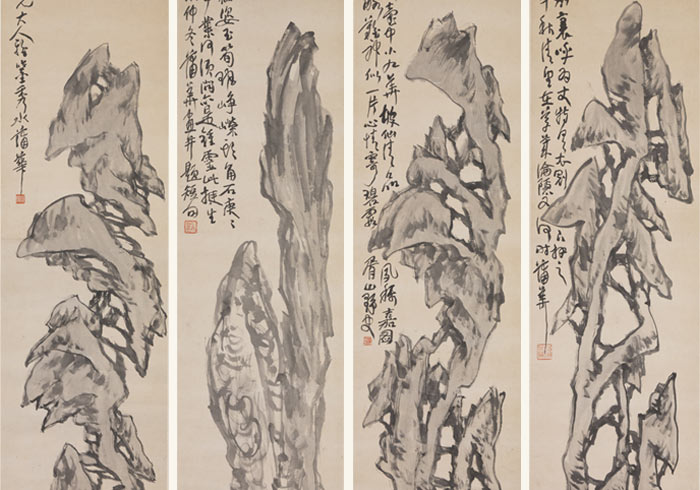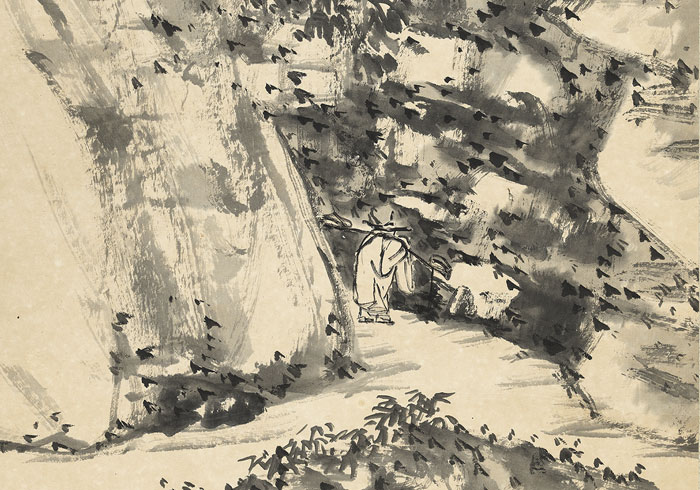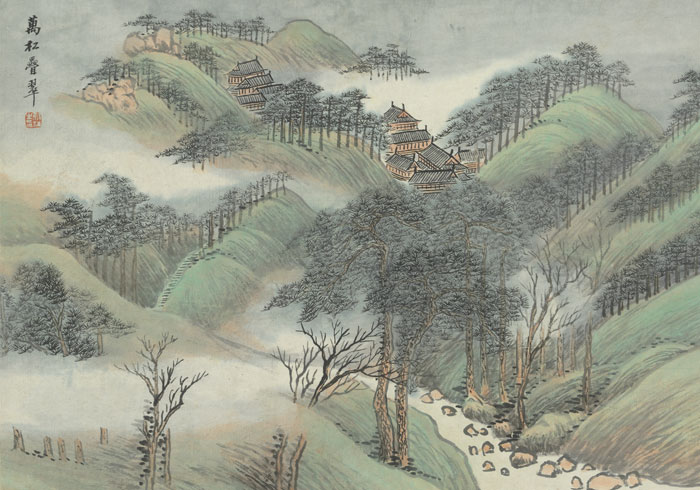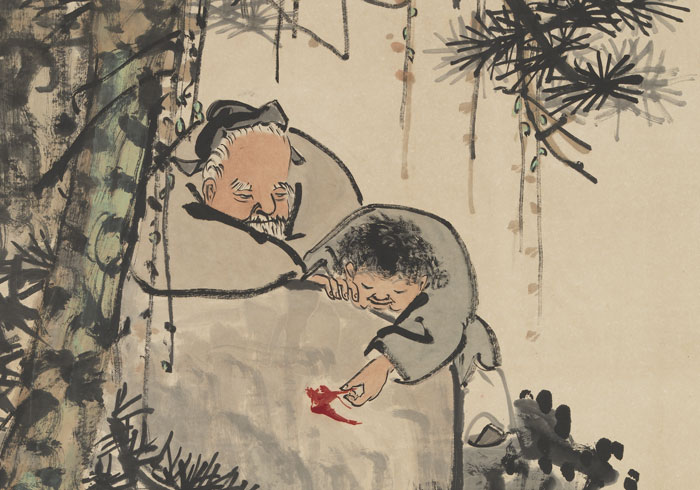In Shanghai art circles focusing mostly on bird-and-flower and figural subjects, some attempts were made in landscape painting to resist populist trends but it actually witnessed major innovation at the hands of various masters, marking a new departure from late Qing traditions. The painters who gathered in Shanghai were also gifted at landscapes and actively pursued ways to avoid the limitations of traditional painting. Among them were artists such as Yang Borun and Pu Hua, who continued in the tradition of the Ming artist Dong Qichang and the Four Wangs of the Qing yet highlighted atmosphere in the landscape through transformations of solid and void. Pu particularly emphasized smooth and fluid brushwork to give his rock-and-bamboo settings a completely new visual experience. Wu Guxiang, following the blue-and-green landscape tradition of the Ming literati artist Wen Zhengming, also pursued beautifully refined brushwork. The artists Gu Yun and Wu Shixian both went to Japan, the former following the style of the Four Wangs of the Qing and becoming a model for Nanga (Japanese literati painting). The latter, after returning to China from Japan, imbued his landscapes with mists and flickering light, which became a quite popular means of expression. Classical brushwork in landscape painting on the one hand was continued by Gao Yong and Lu Hui, with the free and quick strokes of Wu Changshi and Wang Zhen on the other bringing about a completely new look. Huang Shanshou, with his beautifully bright renditions of the land, was also quite popular as an artist.
Four Scrolls of Exotic Rocks
- Pu Hua (1832-1911), Qing dynasty
- Hanging scroll, ink on paper, 135 x 36.4 cm
Pu Hua, a native of Xiushui in Zhejiang, took the civil service examinations and earned the degree of County Candidate, though later he came to earn a living as a painter. During the chaos of the Taiping Rebellion, he left Daizhou and went to Shanghai, spending spend much of his time in Jiaxing and Shanghai.
These four scrolls form a set done for "Honorable Elder Brother Defu" and painted in the winter of the "wuxu" cyclical year, or 1898. In the late nineteenth century, painting sets became popular on the Shanghai art market, and Pu Hua's four scrolls here on unusual garden rocks is an excellent example of such. The artist used ink lines full of dynamism to outline the forms and then light ink washes to shade the surfaces, forming an ink effect of inner luminosity. The poses of the rocks all differ, reflecting all the unique features of openwork, beauty, eccentricity, and smoothness in each one.
Tianping Mountain in Suzhou
- Wu Changshi (1844-1927), Republican period
- Hanging scroll, ink on paper, 147.2 x 39.5 cm
Very few of Wu Changshi's paintings are on the subject of landscapes. This work in monochrome ink features a long five-character archaic poem by the artist, who describes his appreciation of scenery he visited at Tianping Mountain in Suzhou. A perusal of Wu's anthology of poetry indicates this poem was done in reciprocation with Pan Zhongrui (1822-1890). Although the inscription is dated to the "yimao" year (1915), the poem was actually composed much earlier when Pan was still alive.
The painting depicts beautiful mountains overlapping a cliff face in coarse and direct strokes that are quickly hooked, to which dark ink washes have been added for exceptional dynamism. In the lower part of the work is a person carrying a load on a mountain path as he makes his way in this innovative landscape of exceptional uniqueness.
Album of Landscapes After Wang Hui
- Wu Guxiang (1848-1903), Qing dynasty
- Album leaf, ink and colors on paper, 28 x 42 cm
This album of landscapes by Wu Guxiang has ten leaves. As the title suggests, it was patterned after Wang Hui (1632-1717), the Orthodox School master of the early Qing dynasty and, more specifically, Wang's album of "Paintings of Ten Myriads." This theme in painting, quite popular in the Ming and Qing dynasties, is named after the fact that each leaf begins with the Chinese character for (literally) "wan," or "ten thousand," which is also translated as "myriad." Examples of titles include "Myriad Pines of Layered Green" and "Myriad Expanses of Vast Waves."
The landscapes of Wu Guxiang, a native of Suzhou, convey an elegant atmosphere similar to that of the Wu School painter Wen Zhengming in the Ming dynasty. Wu also learned the methods of brush and ink employed by Dai Xi (1801-1860). Although this album is said to be in Wang Hui's landscape manner, it is actually Wu's new collective interpretation of old masters' styles.
Spring and Bat of Complete Fortune
- Wang Zhen (1867-1938), Republican period
- Hanging scroll, ink and colors on paper, 178.2 x 96.2 cm
Wang Zhen (style name Yiting, sobriquet Bailong shanren), a native of Jiaxing in Zhejiang, came from a poor family and became an apprentice in the business world, going on to start his own shipping business. In 1907, he served as chief comprador for a Japanese-invested shipping company, leading to him build his business acumen and become a magnate in the Shanghai business and industrial world. He also took an active role in political and business activities. In 1913, he announced his retirement from the political world and devoted himself instead to relief activities, studying Buddhism, and the arts. A fine painter, he early studied the style of Ren Yi, but after making the acquaintance of Wu Changshi, his painting style became even more dashing.
This painting shows an old man and a child tucked away on a rock above, the latter grasping a bat as another appears by the water. The clever combination of "spring and bat" is a homophone in Chinese for "complete fortune."
